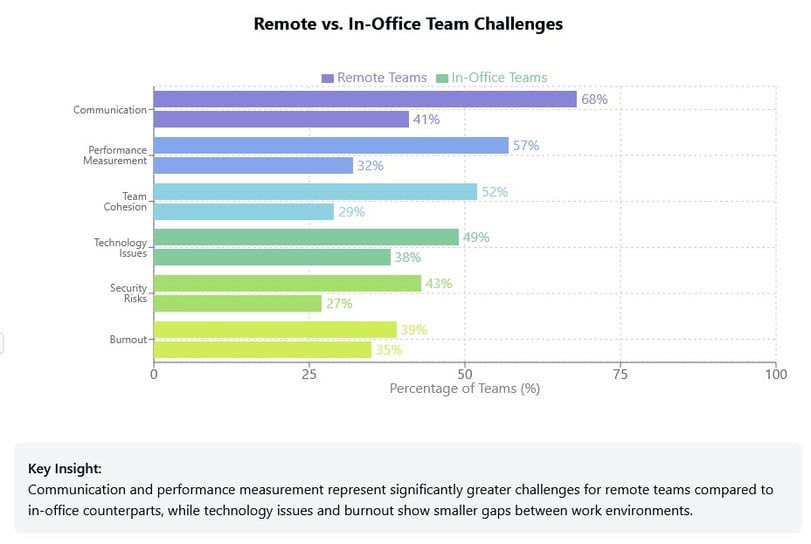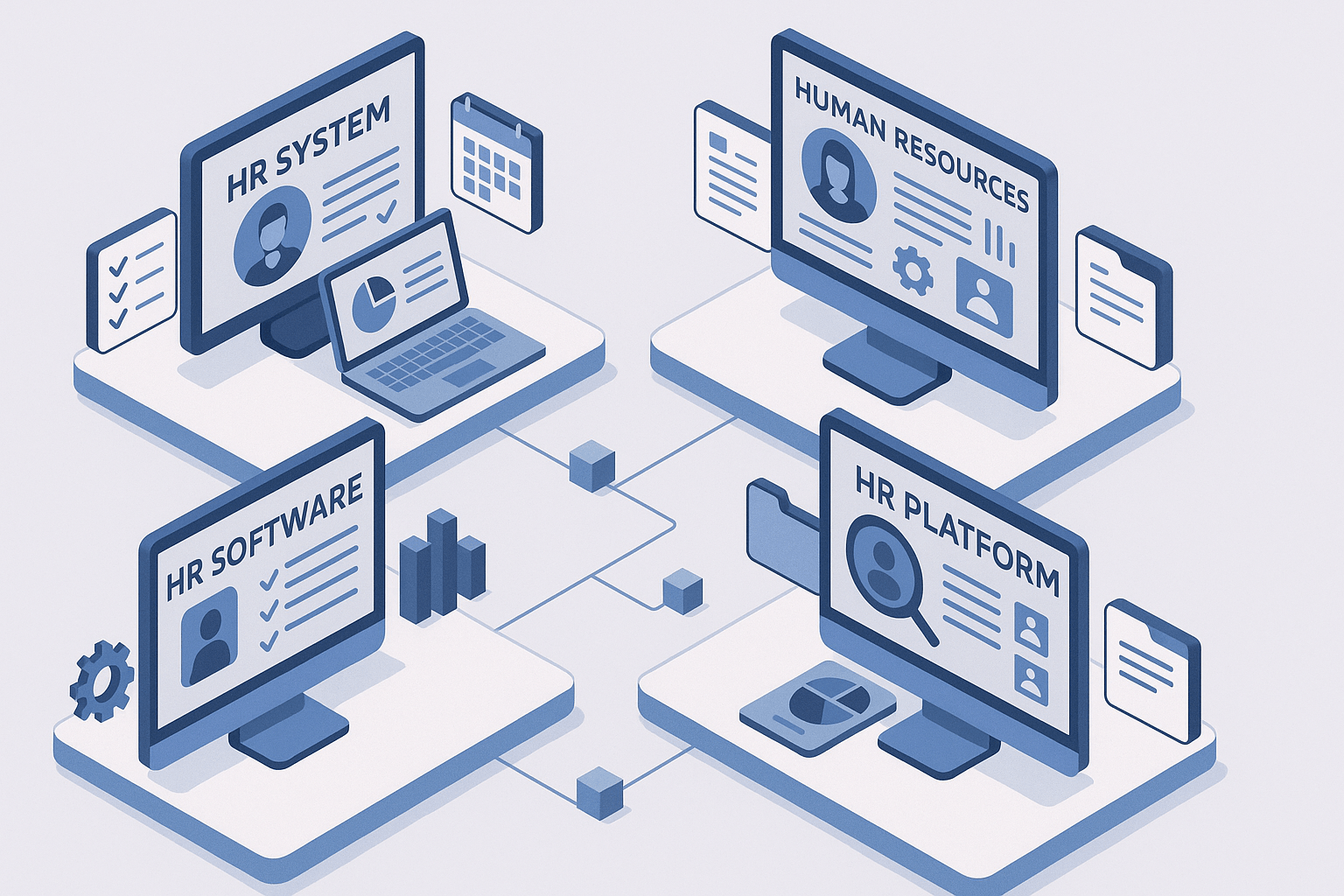From Chaos to Clarity: 5 Essential Policies for Remote Work Success
May 12th, 2025
6 min read

Remember the scramble to go remote? What felt temporary for many teams has become the new normal. But the hasty setup often left behind a messy reality: frustrating communication gaps, swings in team morale, murky productivity tracking, and policies that were... well, non-existent. Remote work is now a permanent, strategic business model, yet many companies still grapple with outdated methods and unclear expectations that hinder success.
At Lift HCM, we've helped numerous businesses navigate this shift, transitioning from reactive remote setups to structured, thriving distributed teams. Drawing on this deep experience, this article explores how remote work has fundamentally evolved, the persistent challenges businesses face, the five critical policy areas every robust remote strategy must address, and the significant benefits of getting this framework right.
Whether your team is fully remote, hybrid, or adapting to increased flexibility, this article offers clarity and practical guidance to build a remote work model that succeeds for both your business and your employees.
Table of Contents
- The Shift to Remote Work
- Remote Work Challenges Businesses Still Struggle With
- 5 Essential Policies for a Sustainable Remote Strategy
- Implementation Roadmap: Your 30/60/90 Day Plan
- From Remote Work Challenge to Strategic Advantage
The Shift to Remote Work
Remote work isn't just a pandemic response anymore—it's a fundamental, enduring shift and a competitive necessity for attracting and retaining top talent. What began as a gradual technological evolution has rapidly transformed into a core business model across virtually all industries.
The move to distributed teams persists for three compelling reasons:
- Talent Expectations: Workplace flexibility is no longer a perk but a decisive factor. 83% of professionals now consider it a key element when evaluating job opportunities, making flexibility critical for hiring and retention.
- Business Benefits: Beyond access to a wider talent pool, companies realize significant cost savings (an average of $11,000 per employee annually through reduced overhead) and improved employee retention.
- Technological Infrastructure: The evolution of cloud computing, collaboration platforms, and high-speed internet now provides robust, reliable support for seamless distributed team operations.
📊 Key Insight: Organizations with structured remote work policies report 22% higher employee retention and 35% improved productivity compared to those with ad-hoc arrangements.
Remote Work Challenges Businesses Still Struggle With
Let’s be honest—transitioning to remote work wasn't all sunshine and Slack channels for everyone. While the benefits are clear, so are the significant growing pains many organizations continue to experience. If you've felt the tension, disconnection, or inefficiency trying to manage a remote or hybrid team, you're not alone.
Here are the core challenges most businesses consistently run into:
- Communication Breakdowns: Without the spontaneous interactions of a physical office, messages easily get lost, priorities can become misaligned, and information silos develop between individuals or teams. This lack of clear, consistent communication channels leads to confusion and inefficiency.
- Employee Isolation and Burnout: The natural social connections of the workplace are missing. Remote employees can experience feelings of disconnection and isolation, which left unaddressed, lead to decreased engagement, lower morale, and an increased risk of burnout and eventual turnover. The lines between work and personal life can also blur, exacerbating stress.
- Security Risks and Data Vulnerability: Distributed teams accessing company data and systems from various locations significantly multiply potential access points and security vulnerabilities. Unsecured home networks, personal devices, and inconsistent data handling practices pose substantial risks to sensitive information.
- Performance Measurement Difficulties: Traditional, presence-based management approaches simply fail in a remote environment. Managers struggle to gauge productivity and impact when they can't physically see employees working, leading to reliance on outdated metrics or a lack of clear performance visibility.

These challenges highlight that simply allowing remote work isn't enough. A reactive approach creates friction and hinders performance. What's needed is a proactive, structured framework.
5 Essential Policies for a Sustainable Remote Strategy
Moving from managing remote challenges to achieving remote success requires a deliberate, formalized approach. A sustainable remote work strategy isn't built on hoping for the best; it requires clear, formal policies across five critical domains. These pillars create the essential foundation for effective, secure, and engaging remote work.
Here are the five core areas every effective remote-work policy needs to cover:
1. Communication Frameworks
Effective remote teams need more than just communication tools—they need clear protocols for when, how, and why to use them. A comprehensive communication policy ensures everyone is on the same page and information flows efficiently.
What it includes:
- Documented expectations for response times across different channels (e.g., instant message vs. email).
- Guidelines on using specific tools for different purposes (e.g., Slack for quick questions, email for formal updates, project software for task discussions).
- Meeting protocols covering purpose, required preparation, agenda structure, and documentation of outcomes.
- Clear escalation paths for urgent issues that require immediate attention.
- Guidelines for asynchronous communication etiquette and best practices.
2. Technology Infrastructure
Remote work demands a deliberate technology ecosystem that balances functionality, security, and usability. This policy covers the tools required and how they are supported.
What it includes:
- List of approved collaboration platforms, project management systems, communication tools (video, chat), and file-sharing solutions.
- Minimum technical requirements for employee home setups (internet speed, device specifications).
- Policy on company-provided equipment vs. using personal devices (BYOD) and associated security requirements.
- Guidelines for accessing necessary software and platforms, including VPN usage.
- Clear procedures for requesting technical support and troubleshooting common issues remotely.
💡Pro Insight: MediaCore, a global marketing agency, improved cross-team collaboration by 34% in 90 days by adopting a "remote-first" policy with virtual meeting options and default documentation.
3. Results-Based Performance Management
Remote work thrives when the focus shifts from activity and presence to measurable outcomes and impact. A robust performance policy for remote teams defines expectations and how performance is evaluated.
What it includes:
- Frameworks for setting clear, measurable objectives and key results (OKRs) or KPIs for all roles, regardless of location.
- Requirements for regular check-ins (e.g., weekly or bi-weekly one-on-ones) focused on progress, roadblocks, and employee well-being.
- Standards for transparent documentation of expectations, goals, and performance feedback accessible to both managers and employees.
- Performance review processes centered on results achieved and contributions made, rather than hours logged or perceived "busyness."
- Guidelines and training for managers on providing effective virtual feedback and coaching.
4. Intentional Culture-Building
Remote culture doesn't develop by chance—it requires deliberate design, investment, and consistent effort to keep employees connected, engaged, and aligned with company values.
What it includes:
- Structured onboarding processes that clearly communicate company values, remote norms, and tools.
- Guidelines and budget for regular virtual team-building activities, social events, and informal connection opportunities (e.g., virtual coffee breaks, water cooler channels).
- Formal and informal recognition programs designed for visibility in a remote environment.
- Expectations for leadership involvement and visibility in digital communication spaces.
- Strategies for collecting employee feedback specifically on the remote experience and company culture.
5. Security Protocols
Distributed teams necessitate a security framework designed for a flexible, decentralized environment. This policy is crucial for protecting company data and systems.
What it includes:
- Mandatory multi-factor authentication (MFA) for accessing all company systems and applications.
- Minimum security standards for home networks (e.g., strong password policies, firewall usage).
- Clear procedures for handling, storing, and transmitting sensitive data securely when working remotely.
- Policies on approved software usage and prohibitions on installing unauthorized applications on work devices.
- Requirements for regular security awareness training and simulated phishing exercises for all remote staff.
- Protocols for reporting security incidents immediately.
💡Pro Insight: Effective remote work policies aren't static documents. Leading organizations implement quarterly reviews of technology use, communication effectiveness, performance metrics, security compliance, and employee engagement data to refine and update their policies continually.
Implementation Roadmap: Your 30/60/90 Day Plan
Transitioning to effective remote work requires a structured approach with clear milestones.
First 30 Days: Assessment & Planning
This foundational phase focuses on understanding your current remote capabilities, identifying gaps, and beginning policy drafting.
- Conduct a comprehensive remote work readiness assessment (covering technology, skills, culture, current practices).
- Analyze existing workflows to inform communication protocol drafting.
- Identify technology gaps through stakeholder interviews and technical audits.
- Begin drafting initial versions of the five core policy documents.
- Establish baseline metrics (productivity, engagement scores, IT tickets related to remote issues) for future comparison.
- Quick Win: Implement a standardized meeting format (clear agenda, pre-work, documented follow-ups) immediately to improve collaboration effectiveness.
Days 31-60: Infrastructure Setup
This implementation phase builds the necessary technical and procedural foundations defined in the policies.
- Deploy or configure your core technology stack according to policy requirements (e.g., collaboration tools, security software).
- Conduct thorough manager training on remote leadership principles, outcome-based management, virtual feedback, and recognizing remote burnout signs.
- Finalize and communicate clear performance metrics and documentation standards aligned with the performance management policy.
- Critical Focus: Ensure security compliance training is underway, and standards for secure remote access and data handling are clearly communicated and beginning to be enforced.
Days 61-90: Culture, Optimization & Feedback
The refinement phase shifts attention to embedding the policies into the company culture and establishing a cycle of continuous improvement.
- Launch intentional culture-building initiatives based on your policy (virtual team events, recognition programs).
- Formally roll out and ensure accessibility of the finalized five key policies to all employees.
- Collect initial feedback through structured surveys targeting both the practical implementation and the cultural impact of the remote policies.
- Use early adoption patterns and feedback to identify friction points and refine policies.
From Remote Work Challenge to Strategic Advantage
Remote work began as a crisis response, with hastily implemented tools leading to communication gaps and security issues. The cost has been significant—74% of companies report productivity challenges due to poor implementation.
Now you understand that effective remote work requires comprehensive policies across five domains. Structured strategies deliver tangible results: 22% higher retention, 35% improved productivity, and significant cost savings.
Tomorrow's leaders will transform remote work from necessity to competitive advantage. The right approach balances flexibility with accountability, enabling access to global talent and greater organizational resilience.
Don't let your organization fall behind in the remote work revolution. At Lift HCM, we've helped hundreds of businesses across industries transform their remote work approaches from reactive to strategic. Our proven methodology addresses each of the five policy pillars with customized solutions that align with your unique business objectives.
Ready to transform your remote work approach?
Caitlin Kapolas is a results-driven professional with a strong background in account management and retail. She is dedicated to improving client experiences and building lasting relationships. Caitlin excels in identifying client needs, resolving issues, and implementing customized solutions that drive value. Her effective communication skills ensure high client satisfaction and loyalty, making her a trusted advisor and partner in meeting client needs with precision and professionalism.









.png?width=473&height=315&name=Digital%20Employee%20Experience%20DEX%20in%20HCM-21%20(1).png)





















